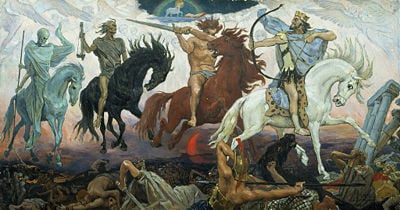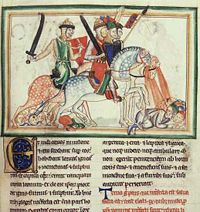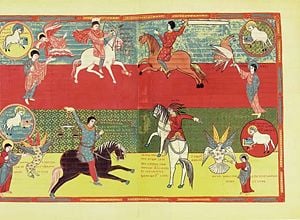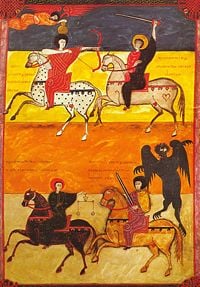Difference between revisions of "Four Horsemen of the Apocalypse" - New World Encyclopedia
m (→White Horse) |
|||
| Line 47: | Line 47: | ||
===White Horse=== | ===White Horse=== | ||
| − | [[Image:BritLibAddMS35166ApocalypseFolio016rFourHorsemen.jpg|thumb| | + | [[Image:BritLibAddMS35166ApocalypseFolio016rFourHorsemen.jpg|thumb|200px|left|The Four Horsemen, with the white horse in the foreground]] |
The first horse is described as follows: "I watched as the Lamb opened the first of the seven seals. Then I heard one of the four living creatures say in a voice like thunder, "Come!" {2} I looked, and there before me was a white horse! Its rider held a bow, and he was given a crown, and he rode out as a conqueror bent on conquest" (Rev 6:1-8 NIV). | The first horse is described as follows: "I watched as the Lamb opened the first of the seven seals. Then I heard one of the four living creatures say in a voice like thunder, "Come!" {2} I looked, and there before me was a white horse! Its rider held a bow, and he was given a crown, and he rode out as a conqueror bent on conquest" (Rev 6:1-8 NIV). | ||
| Line 57: | Line 57: | ||
===Red Horse=== | ===Red Horse=== | ||
| + | [[Image:BritLibAddMS35166ApocalypseUnkFolio2SealRedHorse.jpg|thumb|The Red Horse]] | ||
The second horseman is described as riding a red horse: "When the Lamb opened the second seal, I heard the second living creature say, "Come!" Then another horse came out, a fiery red one. Its rider was given power to take peace from the earth and to make men slay each other. To him was given a large sword." (Rev 6:3-4 NIV). | The second horseman is described as riding a red horse: "When the Lamb opened the second seal, I heard the second living creature say, "Come!" Then another horse came out, a fiery red one. Its rider was given power to take peace from the earth and to make men slay each other. To him was given a large sword." (Rev 6:3-4 NIV). | ||
| Line 62: | Line 63: | ||
===Black Horse=== | ===Black Horse=== | ||
| + | [[Image:BritLibAddMS35166ApocalypseUnkFolio3SealBlackHorse.jpg|thumb|left|The Black Horse]] | ||
The third horseman is described as riding a black horse: "When the Lamb opened the third seal, I heard the third living creature say, "Come!" I looked, and there before me was a black horse! Its rider was holding a pair of scales in his hand. Then I heard what sounded like a voice among the four living creatures, saying, "A quart of wheat for a day's wages, and three quarts of barley for a day's wages, and do not damage the oil and the wine!" (Rev 6:5-6 NIV). | The third horseman is described as riding a black horse: "When the Lamb opened the third seal, I heard the third living creature say, "Come!" I looked, and there before me was a black horse! Its rider was holding a pair of scales in his hand. Then I heard what sounded like a voice among the four living creatures, saying, "A quart of wheat for a day's wages, and three quarts of barley for a day's wages, and do not damage the oil and the wine!" (Rev 6:5-6 NIV). | ||
[[http://catholic-resources.org/Dore/Images/NT-237-med.jpg|thumb|The Pale Horse]] | [[http://catholic-resources.org/Dore/Images/NT-237-med.jpg|thumb|The Pale Horse]] | ||
| Line 78: | Line 80: | ||
===Preterism=== | ===Preterism=== | ||
| − | The term | + | The term ''Preterism'' comes from Latin for "past." Preterists believe that all or part of the events described in the [[Book of Revelation]] occurred in the past. |
| − | + | ''Full Preterists'' believe these events were fulfilled with the fall of [[Jerusalem]] and the destruction of the Temple of Jerusalem in 70 C.E. by the [[Roman Empire]] (which is identified as "the beast"), thus initiating the start of the Christian age. The [[Last Days]] are thus identified as the time period between the ministry of [[John the Baptist]] and the fall of Jerusalem, and the tribulation is identified as the destruction of Jerusalem and the forced exile of its people. <ref>This view is held by many Catholics ((seeciteeb|url=http://www.catholic.com/library/Whore_of_Babylon.asp|title=The Whore of Babylon|publisher=Catholic Answers|accessdate=2007-05-11}}</ref> | |
| − | + | ''Partial Preterists'' divide end-times prophecy into several parts. In this view, certain parts of Revelation have yet to be fulfilled, such as the resurrection of the dead and the coming of the heavenly New Jerusalem. Partial '''Preterists''' also believe that part of the Book of Revelation is literal while other parts are symbolic. | |
==='''Futurist''' view=== | ==='''Futurist''' view=== | ||
Revision as of 20:59, 27 September 2007
The Four Horsemen of the Apocalypse is described in Chapter 6, verses 1-8 in the Book of Revelations, also known as the Apocalypse of John, the last book of the New Testament. The Four Horsemen are described as four different riders on four different horses of different colors —White, Red, Black, and Pale. Due to the extensive use of imagry and symbols that is used to describe various unfolding events, there is no consensus as to its meaning.
The vision of the Four Horsemen describes events related the Last Days interpreted by some as relating to the future and by other as describing events occuring in the times when the authoro of the Book of Revelation was writing, during the pre-Christian Roman Empire. Still others believe that the events or should be interpreted alegorically, as spiritual truths that have eternal meaning.
The Horses and Their Riders
| Horse | Horse Represents | Rider | Power | Rider Represents | Original Greek Description |
|---|---|---|---|---|---|
| White | Victory; Pure Warfare | Carries a bow, wears a crown | Conquest | Christ or Antichrist | ίππος λευκός (híppos leukós), [The] White Horse |
| Red | Blood spilled on the battlefield | Carries a sword | War | War | ίππος πυρρός (híppos purrós), [The] Fiery Red Horse |
| Black | Desolation | Carries scales | Famine, Persecution | Injustice to the poor and scarcity of food | ίππος μέλας (híppos mélas), [The] Black Horse |
| Pale | Paleness of skin in death, decay | Followed by Hell | Kills by war, hunger, plagues, etc. | Death | ίππος χλωρός, θάνατος (híppos khlōrós, thánatos), [The] Pale Green Horse, [named] Death |
White Horse
The first horse is described as follows: "I watched as the Lamb opened the first of the seven seals. Then I heard one of the four living creatures say in a voice like thunder, "Come!" {2} I looked, and there before me was a white horse! Its rider held a bow, and he was given a crown, and he rode out as a conqueror bent on conquest" (Rev 6:1-8 NIV).
There are diverse opinions on whether the first horseman, riding a white horse, represents Christ or is the so-called anti-Christ.
Until the time of the Protestant Reformation, the traditional view was that the rider of the white horse was Christ. There are several arguments used by those who support the view that the rider on the white horse is Christ. The Greek word for the crown that the rider is wearing is "Στέφανος (Stephanos|Stéphanos)," the same name of the first Christian martyr. It is also the same crown that is worn by the 24 Elders mentioned in Revelation 5:4. In addition, the horseman on the white horse described in Chapter 6 is later described, in Revelation 19:16, as the "King of kings, the Lord of lords." Rev. 19:11-16 speaks of a rider on a white horse, who comes to defeat the forces of evil.
With the Reformantion, however, some interpreters have viewed the rider on the white horse as the Antichrist. [1]
Red Horse
The second horseman is described as riding a red horse: "When the Lamb opened the second seal, I heard the second living creature say, "Come!" Then another horse came out, a fiery red one. Its rider was given power to take peace from the earth and to make men slay each other. To him was given a large sword." (Rev 6:3-4 NIV).
The rider of the second horse is generally held to represent War. The red color of his horse represents blood spilled on the battlefield. He carries a great sword, which represents battle and fighting. The Red horse is also said to represent the planet Mars. According to astrological beliefs, Mars has quite an ill effect on the Earth when its position is behind us to the Sun, especially when the Moon—interpreted by some as the Pale Horse (the last horse)— is between Mars and the Earth.
Black Horse
The third horseman is described as riding a black horse: "When the Lamb opened the third seal, I heard the third living creature say, "Come!" I looked, and there before me was a black horse! Its rider was holding a pair of scales in his hand. Then I heard what sounded like a voice among the four living creatures, saying, "A quart of wheat for a day's wages, and three quarts of barley for a day's wages, and do not damage the oil and the wine!" (Rev 6:5-6 NIV). [Pale Horse]
This third horseman is generally used to mean that a great famine will take place in some future period of time (or it has already taken place, depending on how one interprets the Book of Revelations), likely as a result of the war that comes from the second horseman. Food will be scarce, but luxuries such as wine and oil will still be readily available.
Pale Horse
The fourth horseman is described as riding a pale horse. His named is specifically referred to as "Death". "I heard the voice of the fourth living creature say, "Come!" I looked, and there before me was a pale horse! Its rider was named Death, and Hades was following close behind him. They were given power over a fourth of the earth to kill by sword, famine and plague, and by the wild beasts of the earth (Rev. 6:7-8).
The pale greenish color of the fourth horse is said to represent fear, sickness, decay, and death. Note: the word used to describe the color of the 'pale' horse is the Greek word chloros or green. It is meant to convey the sickly green tinge of the deathly ill or recently dead. Since the literal translation 'green' does not carry these connotations in English the word is rendered 'pale' in most English translations)
Interpretations
There are 4 basic schools of thought on how the Book of Revelations is to be interpreted. It is this very reason that the Book of Revelations is often misunderstood and misquoted.
Preterism
The term Preterism comes from Latin for "past." Preterists believe that all or part of the events described in the Book of Revelation occurred in the past.
Full Preterists believe these events were fulfilled with the fall of Jerusalem and the destruction of the Temple of Jerusalem in 70 C.E. by the Roman Empire (which is identified as "the beast"), thus initiating the start of the Christian age. The Last Days are thus identified as the time period between the ministry of John the Baptist and the fall of Jerusalem, and the tribulation is identified as the destruction of Jerusalem and the forced exile of its people. [2]
Partial Preterists divide end-times prophecy into several parts. In this view, certain parts of Revelation have yet to be fulfilled, such as the resurrection of the dead and the coming of the heavenly New Jerusalem. Partial Preterists also believe that part of the Book of Revelation is literal while other parts are symbolic.
Futurist view
This view believes that the Book of Revelation is a prophecy of future events to come, which will occur shortly before the second coming of Christ. Futurist interpretations predict a resurrection of the dead as well as those who have not yet reached an age of accountability, and a rapture with Jesus. All "true" Christians will be gathered to Christ at the time God's kingdom comes on earth.
Historicist or Historical view
The historicist or historical view regards the prophecy in Revelation as being in the process of being fulfilled. That process started at the end of the first century and will continue through the second coming of Christ.
Under this school, historical interpretations apply the symbols of Revelation to the gradual division and collapse of the Roman Empire, the emergence of a divided Europe in the West and a Muslim empire in the East, and the collapse of the Eastern Empire while Europe attempts to reunite and recreate the Roman Empire. According to historical interpretations, the second coming of Christ occurs about the time that a partly reunited Europe starts to wage war against Israel. This view is held mainly by Fundamentalist Protestant Christians, wuch as Martin Luther, John Wesley, John Wycliffe, William Tyndale, John Calvin, John Knox, Isaac Newton, Charles Finney, and C.H. Spurgeon.
Historical interpretations see the expansion of the Church, despite its persecution. However, they see the majority of people throughout the world as gradually evolving into disbelief, in which true Christians will be a persecuted minority. This view is associated with an Antichrist system which exists for much of history rather than expecting a single Antichrist in the last days. The "beast" in Revelation 13 was commonly interpreted to be the papacy of the Roman Catholic Church.
Spiritual or Idealist view
The Spiritual view, also called Idealist view, does not see the contents of the Book of Revelation as literal. Rather its language is symbolic, and each generation can read and interpret it in their own way. The various visions in the Book of Revelations express eternal spiritual truths and struggles that are without any literal or historical application. Revelation is seen, as well as all of scriptures, as having several levels of meaning, which range from a strict and literal interpretation to an interpretation that cannot be understood and interpreted only on the basis of one's intellect.
Relationship to the Book of Zechariah
Four sets of horses are similarly depicted in Chapter 6, verses 1-8 in the book of Zechariah, the second to last Book in the Old Testament. Zechariah's writings are filled with Messianic references and passages that deal with the end of times, as was understood at that particular period of time. Zechariah is quoted in the Book of Revelation more than any other book in the Old Testament. The first nine chapters of Zechariah are considered apocalyptic like the Book of Revelation. This Old Testament writing is also quoted frequently by many other New Testament authors. These particular verses in Zechariah have been used by some individuals to argue that the rider of the white horse in the Book of Revelation is not the Antichrist. In Zechariah, all of the horses and riders are servants of the Lord. If these horses are the same four horses and riders as the Four Horsemen, this would suggest that rider of the white horse in the Book of Revelation is not the Antichrist, and the likelihood that the Four Horsemen in the Book of Revelation is an adaptation of the Book of Zechariah.
The text in the book of Zechariah (Zech 6:1-7) reads as follows: (Revised Standard Version)
"1. And again I lifted my eyes and saw, and behold, four chariots came out from between two mountains; and the mountains were mountains of bronze. 2. The first chariot had red horses, the second black horses. 3. The third white horses, and the forth chariot dappled gray horses. 4. Then I said to the angel who talked to me, "What are these, my lord? 5. And the angel answered me, "These are going forth to the four winds of heaven, after presenting themselves before the Lord of all the earth. 6. The chariot with the black horses goes towards the north country, the white ones go toward the west country, and the dappled ones go toward the south county. 7. When the steeds came out, they were impatient to get off and patrol the earth. And he said, "Go, patrol the earth. So they patrolled the earth". 8. Then he cried to me, "Behold , those who go toward the north country have set my Spirit at rest in the north country".
Note: In the King James version, the color of the fourth horse is described as "grisled and bay". Matthew Henry, in his Commentary, states that the traditional interpretation given to his this passage was that the four chariots, drawn by horses, each with a different color, represented four different monarchies: the Babylonian monarchy, the Persian monarchy, the Grecians, and the Romans. However, Henry had a different opinion: He believed that the vision represented the administration of the kingdom of Providence in the government of this "lower" world. The fact that there are so many conflicting interpretations underscores the inability to have a consensus on how to interpret this particular passage in Zechariah and the Book of Revelations.
Significance
The Book of Revelations contains an account of visions which are symbolic and allegorical language. Although there is no proof, it can be speculated that some of it at least came from Old Testament sources, such as Ezekiel, Zechariah, and Daniel. Whether or not these visions were real experiences of the author or simply literary conventions employed by John is an open question.
This much, however, is certain: The Four Horsemen of the Apocalypse cannot be adequately understood except against the historical background in which the Book of Revelation was written. Like the Book of Zechariah and other Old Testament apocalypses, it is composed as resistance literature to meet a crisis, which was the ruthless persecution of the early Christian church by the Roman government. This book is thus seen as an exhortation and admonition to Christians of the first century to stand firm in their faith and to avoid compromise with paganism, despite the threat of death. The early Christians were encouraged to wait for the fulfillment of the promises made by Jesus, which would be the triumph of God's sovereignty.
This book remains just as valid today for present day Christians who believe that the prophecies in Revelation applies to events of today. They are thus encouraged, as the first century Christians were encouraged, to remain faithful to the end, in the face of the serious problems confronting today's world, and to have faith and trust in the promise of Jesus, "Behold, I am with you always, until the end of the age" (Matthew 28:20).
ReferencesISBN links support NWE through referral fees
- Friesen, Steven J. "Imperial Cults and the Apocalypse of John". Oxford University Press, 2006. ISBN: 978-0195131536
- Henry, Matthew "Matthew Henry's Commentary".Zondervan, 1960. ISBN: 0-10-26010-8
External Links
- http://www.earlychristianwritings.com/revelation.html.Retrieved September 21, 2007
- http://www.newadvent.org/cathen/01594b.htm. Retrieved September 17, 2007
- http://www.ambs.edu/LJohns/APJN.htm. Retrieved September 13, 2007
- http://www.directionjournal.org/article/?1400 Retrieved September 12, 2007
- http://www.nccbuscc.org/nab/bible/revelation/intro.htm Retrieved September 2, 2007
- http://www.preteristarchive.com/ChurchHistory/index.html Retrieved September 3, 2007
- http://www.preteristarchive.com Retrieved September 8, 2007
- http://en.wikipedia.org/wiki/Book_of_Revelation. Retrieved September 8, 2007
- http://www.apocalipsis.org/rev-6.htm#seals. Retrieved September 8, 2007
Credits
New World Encyclopedia writers and editors rewrote and completed the Wikipedia article in accordance with New World Encyclopedia standards. This article abides by terms of the Creative Commons CC-by-sa 3.0 License (CC-by-sa), which may be used and disseminated with proper attribution. Credit is due under the terms of this license that can reference both the New World Encyclopedia contributors and the selfless volunteer contributors of the Wikimedia Foundation. To cite this article click here for a list of acceptable citing formats.The history of earlier contributions by wikipedians is accessible to researchers here:
The history of this article since it was imported to New World Encyclopedia:
Note: Some restrictions may apply to use of individual images which are separately licensed.
- ↑ Kreider, Glenn. Jonathan Edwards' Interpretation of Revelation 4:1-8:1. Univ. Press of America, 2004.
- ↑ This view is held by many Catholics ((seeciteeb|url=http://www.catholic.com/library/Whore_of_Babylon.asp%7Ctitle=The Whore of Babylon|publisher=Catholic Answers|accessdate=2007-05-11}}






